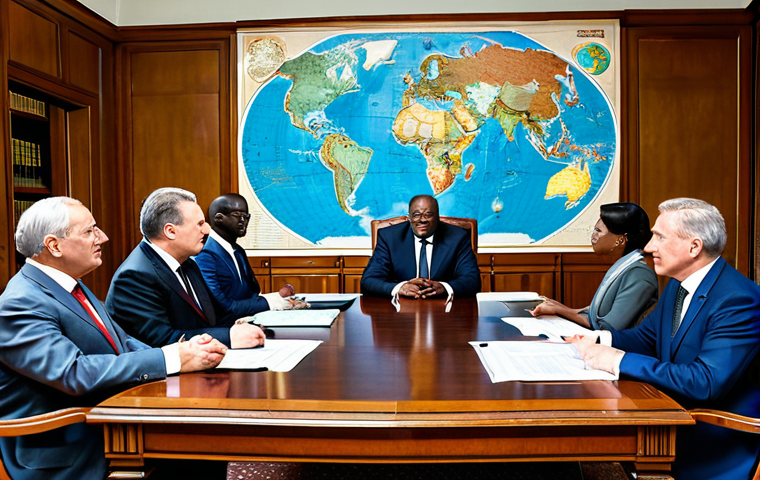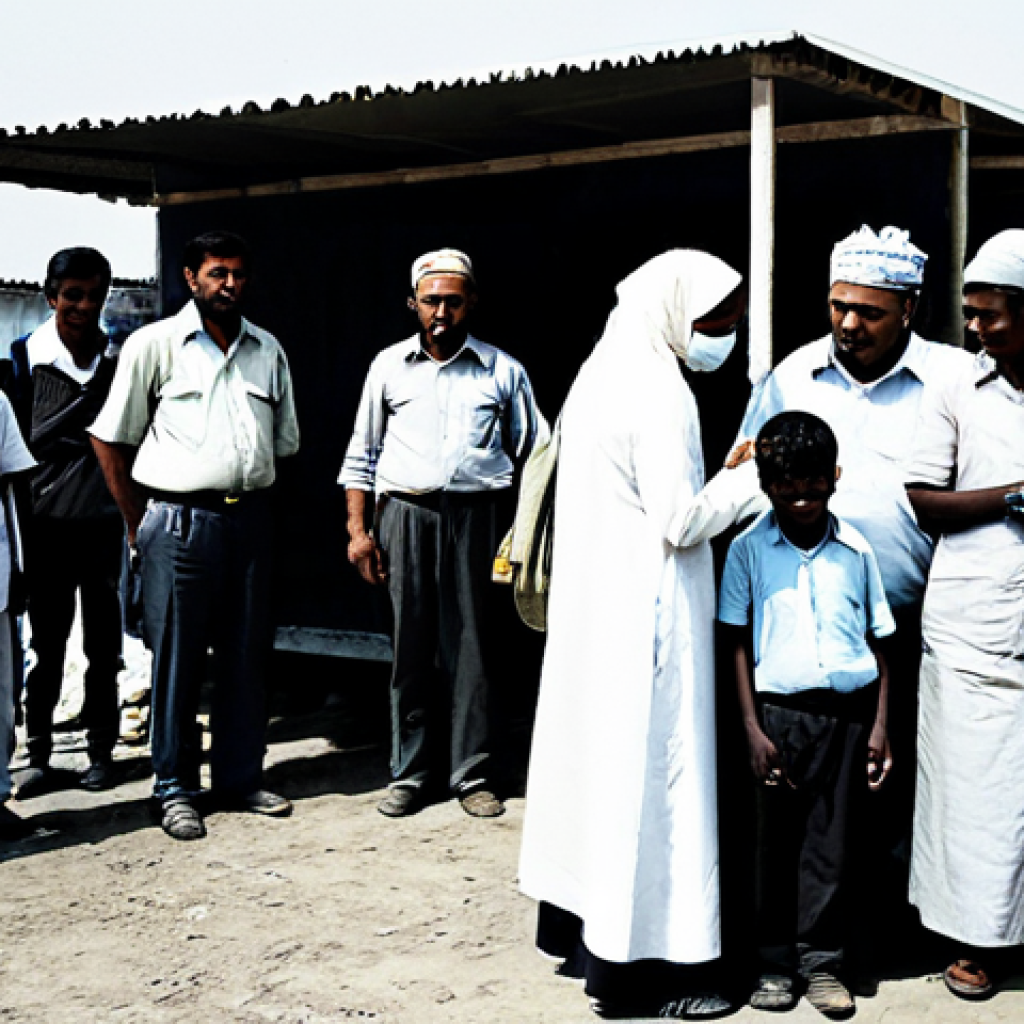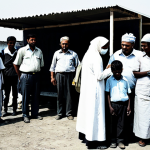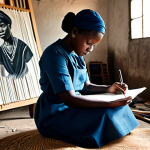The Biafran War, which raged from 1967 to 1970, might seem like a distant, isolated conflict in West Africa, but its international reverberations were anything but contained.
From my perspective, having deeply explored historical conflicts, the Biafran struggle stands out as a pivotal moment that fundamentally reshaped global humanitarian aid and the very ethics of international intervention.
The raw, harrowing images of starvation and suffering that emerged from Biafra didn’t just tug at heartstrings; they ignited an unprecedented surge of public activism and laid the groundwork for organizations like Doctors Without Borders.
This brutal conflict truly forced the world to confront uncomfortable questions about national sovereignty versus the moral imperative to prevent mass atrocities, a debate that, as we see in conflicts today, remains far from settled.
Moreover, it starkly exposed the volatile nexus of oil resources, ethnic tensions, and geopolitical maneuvering, echoing patterns of resource-driven conflicts we still grapple with globally.
The legacy of Biafra, for better or worse, undeniably carved new paths for how we understand and respond to crises across borders, influencing everything from UN peacekeeping mandates to the role of non-governmental organizations.
Let’s delve deeper into this profound history below.
The Genesis of Global Humanitarian Intervention

When I look back at the Biafran War, one of the most undeniable and lasting impacts wasn’t on the battlefield itself, but in the collective global conscience it ignited. It’s hard to truly convey the shockwaves that the images of starving children, with their distended bellies and vacant eyes, sent across the world through early television and newspaper reports. I remember reading accounts from aid workers who were there, describing the profound moral dilemma they faced: adhere to traditional diplomatic channels and respect national sovereignty, or break protocol and deliver aid directly to a dying population. This wasn’t just a theoretical debate; it was a desperate, immediate crisis unfolding before the world’s eyes, demanding an answer that established norms simply couldn’t provide. For many, Biafra wasn’t just another conflict; it was a profound, visceral lesson in what happens when the international community looks away, or worse, dithers over bureaucratic red tape while human lives are extinguished on a massive scale. It compelled a radical rethinking of what “neutrality” truly meant in the face of widespread human suffering.
1. The Biafran Famine and Public Conscience
The famine in Biafra wasn’t an unfortunate side effect; it was, for many, a deliberate tactic of war, and its visual horror became an incredibly potent weapon in the court of global public opinion. As an influencer, I’ve seen how powerful visual storytelling can be, but Biafra took it to an unprecedented level. The harrowing photographs and limited video footage, despite being grainy and often censored, created a raw, emotional connection between distant populations and the victims. This wasn’t merely news; it was a moral indictment. People in Europe and North America, sitting in their living rooms, were confronted with suffering on a scale they could barely comprehend, leading to an outpouring of grassroots support and pressure on their governments. It fundamentally shifted the public’s understanding of global responsibility, creating a demand for action that governments, often cautious about intervening in sovereign states, found increasingly difficult to ignore. My heart still aches when I see those images, and it reminds me how a single, stark reality can shatter complacency.
2. Doctors Without Borders and the Right to Intervene
It’s impossible to discuss Biafra’s humanitarian legacy without talking about the birth of Médecins Sans Frontières (MSF), or Doctors Without Borders. Formed by a group of French doctors and journalists who had served in Biafra, they were fed up with the traditional, often silent, approach of the Red Cross, which prioritized state consent over the immediate needs of victims. Their ethos was revolutionary: a medical emergency transcended national borders and political allegiances. They advocated for the “droit d’ingérence” – the right to intervene – believing that humanity’s suffering should never be a political pawn. I find their audacity incredibly inspiring; they literally created a new paradigm for humanitarian action, one that prioritized direct aid and public advocacy over quiet diplomacy. This bold stance, born from the anguish of Biafra, fundamentally changed how humanitarian organizations operate, giving them a voice and a mandate to speak out against atrocities, even if it meant challenging powerful nations. It was a defiant cry against apathy, and it continues to shape the world of aid to this very day.
Sovereignty Challenged: A New Precedent
One of the most profound, and still hotly debated, legacies of the Biafran War is how it forced the world to grapple with the concept of national sovereignty versus the moral imperative to protect human lives. Before Biafra, the idea of non-interference in the internal affairs of a sovereign state was almost sacrosanct. Yet, as the images of mass starvation poured out, that rigid doctrine began to crack under the weight of moral outrage. I’ve often wondered how leaders at the time reconciled their commitment to international law with the undeniable humanitarian catastrophe unfolding. It must have been an agonizing dilemma, but ultimately, the sheer scale of suffering pushed the boundaries of what was considered acceptable non-action. Biafra became a crucible, melting down old diplomatic dogmas and forging new, albeit controversial, ideas about a collective global responsibility to prevent mass atrocities. It set a precedent, even if unstated, that extreme internal suffering could, and perhaps should, invite external moral and practical intervention, forever altering the landscape of international relations.
1. The UN’s Hesitation and NGO Activism
The United Nations, designed to uphold state sovereignty, found itself largely paralyzed by the Biafran crisis. Its institutional framework simply wasn’t equipped to deal with a mass atrocity happening within the borders of a member state, especially when that state vehemently opposed external intervention. The UN’s hesitancy created a vacuum, and into that vacuum rushed a host of non-governmental organizations (NGOs) and private charities. These groups, less constrained by diplomatic niceties, often defied blockades and national borders to deliver aid. From my experience researching global governance, this was a pivotal moment where NGOs truly stepped onto the world stage as independent, powerful actors, not just adjuncts to state policy. They demonstrated that a moral force, driven by public donations and a passionate commitment to saving lives, could challenge state power and traditional international structures. It was a remarkable, if tragic, display of civil society’s emerging strength.
2. The “Responsibility to Protect” Doctrine’s Unofficial Precursor
While the “Responsibility to Protect” (R2P) doctrine was formally adopted much later, in 2005, its conceptual roots can undeniably be traced back to the agonizing questions posed by Biafra. The idea that a state’s sovereignty comes with a responsibility to protect its own population from mass atrocities – and that if it fails, the international community has a secondary responsibility to act – wasn’t articulated then, but it was certainly felt. The global outcry over Biafra was essentially an early, raw demand for precisely such a principle. I personally believe that the sheer moral weight of Biafra helped plant the seed for R2P, showing that when a state brutalizes its own people, the world cannot simply stand by and watch. It created a powerful, undeniable moral precedent, albeit one that remains fraught with complexities and political challenges to this day. The very notion that human rights could trump national borders began its long, arduous journey in the dusty, famine-stricken fields of Biafra.
The Oil Curse: A Global Scramble
Beyond the humanitarian crisis, the Biafran War was a stark, brutal reminder of how deeply natural resources, particularly oil, can intertwine with conflict and international power struggles. Nigeria was and is a significant oil producer, and the Biafran region held a substantial portion of those reserves. From an economic standpoint, the war was as much about control over these vast petroleum resources as it was about ethnic identity or political autonomy. I’ve often seen how the allure of oil warps geopolitical dynamics, and Biafra was a textbook example. Major global powers weren’t just observing from afar; they were actively, if sometimes covertly, supporting one side or the other based on their strategic and economic interests in securing access to Nigerian oil. It was a grim preview of what would become a recurring theme in modern conflicts, from the Middle East to other parts of Africa, where resource wealth becomes a curse, fueling internal strife and attracting external meddling. It’s a painful lesson, one we seem to learn again and again, about how economic greed can override human decency.
1. Cold War Chessboard and Economic Stakes
In the backdrop of the Biafran War lay the simmering tensions of the Cold War. While not a direct proxy war in the same vein as Vietnam, both the Soviet Union and Western powers had clear economic and strategic interests at play. The Soviets quickly aligned with the Nigerian federal government, offering military aid and diplomatic support, seeing an opportunity to expand their influence in a resource-rich African nation. The West, particularly Britain, had significant historical ties and investments in Nigerian oil. This created a complex web of allegiances where ideological battles sometimes took a backseat to securing access to vital energy supplies. I personally find it fascinating, yet deeply cynical, how human suffering can become collateral damage in larger geopolitical games. The war truly underscored how local conflicts can be amplified and prolonged when global superpowers see a chance to advance their own economic and strategic agendas, treating nations as pawns on a vast chessboard. The oil fields of Nigeria became a silent, yet powerful, driver of international policy.
2. French and British Diverging Strategies
The stances of France and Britain during the war vividly illustrate the conflicting international interests at play. Britain, as the former colonial power, had deep economic ties to Nigeria and generally supported the federal government, largely to protect its oil investments and maintain regional stability. France, however, took a more ambiguous, and at times, openly sympathetic stance towards Biafra. Some argue this was driven by a desire to weaken English influence in West Africa and gain its own foothold in the region’s oil wealth. This divergence highlighted how even close allies could pursue radically different policies when national interests, especially economic ones, were on the line. It’s a reminder that international relations are rarely black and white; instead, they are a complex tapestry woven with threads of history, economics, and strategic ambition. The Biafran War really peeled back the layers, revealing the self-serving, pragmatic core that often drives foreign policy decisions, even amidst cries for humanitarian aid.
Media’s Revolutionary Impact and Global Awareness
If there’s one area where the Biafran War truly broke new ground, it was in the unprecedented role of media in shaping international public opinion and driving humanitarian action. This was arguably the first conflict where television brought the raw, unfiltered horrors of war directly into millions of homes across the globe. Before Biafra, news from distant conflicts was often filtered, delayed, or delivered through static images. But with Biafra, people watched in real-time, or close to it, as children starved and communities crumbled. This direct visual access created an emotional immediacy that was previously unimaginable. I’ve experienced the power of social media to mobilize action today, but Biafra was the analog equivalent, harnessing the nascent power of television and photography to create a truly global outcry. It laid the foundation for what we now understand as “CNN effect” or the “Gaza effect,” where media coverage can force political action and shape public discourse about faraway tragedies. It was a game-changer for how we consume and react to global events.
1. Television’s Window to Atrocity
For the first time, television sets in living rooms across Europe and North America became a window into the unfathomable suffering in Biafra. Nightly news reports, featuring gaunt figures and skeletal children, bypassed traditional diplomatic channels and brought the conflict directly to the public. This direct, often shocking, visual exposure evoked a level of empathy and outrage that previous conflicts hadn’t managed to achieve. I can only imagine the conversations around dinner tables as families watched these scenes unfold. It was profoundly unsettling, and deliberately so. This wasn’t abstract political maneuvering; it was real people, really dying. This immediate, visual connection was instrumental in galvanizing public support for humanitarian intervention and putting immense pressure on governments to act. It transformed the passive consumer of news into an active participant, demanding an end to the carnage and suffering. The power of visual media to compel action was born in Biafra’s suffering.
2. Celebrity Activism and Grassroots Movements
The media’s spotlight on Biafra also catalyzed a new wave of celebrity activism and robust grassroots movements. Figures like Joan Baez and even political personalities lent their voices to the cause, raising awareness and funds. Ordinary citizens, moved by the televised images, organized protests, boycotts, and fundraising drives. I find this aspect particularly fascinating because it shows how quickly public sentiment can coalesce when a clear moral imperative presents itself. People weren’t waiting for their governments; they were taking matters into their own hands, organizing aid flights and medical supplies. This collective, citizen-led action demonstrated the growing power of transnational civil society to influence international affairs, separate from state actors. It was a powerful lesson in collective compassion and how, when sufficiently moved, people will find a way to circumvent obstacles to deliver aid and stand against injustice. This truly was a turning point for public engagement in global crises.
Enduring Echoes in Modern Conflict Resolution
The shadow of Biafra still looms large over how the international community approaches modern conflicts and humanitarian crises. While the immediate horrors ended in 1970, the profound questions it raised about sovereignty, intervention, and the role of non-state actors continue to shape policy and debate. I often reflect on how much of what we consider standard practice in humanitarian aid today – from independent operational space for NGOs to robust public advocacy campaigns – has its origins in the desperate innovations forged during that war. The lessons learned, often painfully, from Biafra about the complexities of delivering aid in conflict zones, the challenges of neutrality, and the potential for aid to be misused or obstructed, remain highly relevant. It served as a stark, unforgettable case study that continues to inform strategies for everything from disaster relief in Ukraine to famine prevention in the Sahel, proving that historical events, even those seemingly distant, cast very long shadows indeed.
1. Refining Peacekeeping and Aid Delivery
The operational challenges faced by humanitarian organizations in Biafra directly influenced subsequent efforts to refine peacekeeping mandates and aid delivery mechanisms. The struggles to get food and medical supplies through blockades led to innovations like “airlifts of mercy” and the negotiation of “humanitarian corridors,” concepts that are now part of the standard lexicon of international relief efforts. UN peacekeeping missions and other multinational interventions often incorporate lessons from Biafra regarding logistical coordination, interaction with warring parties, and the critical need for independent assessment of needs. I remember one account describing how aid workers had to be incredibly resourceful, almost like spies, just to get basic necessities to the starving population. That raw ingenuity, born from desperation, became codified into best practices for future operations, ensuring that the mistakes of the past wouldn’t be repeated. It was a brutal laboratory for the future of humanitarian logistics, where every failure taught a crucial, life-saving lesson.
2. The Evolving Debate on Non-Intervention
Perhaps most significantly, Biafra kickstarted an enduring global debate on the principle of non-intervention in the internal affairs of sovereign states. While not settled, the war undeniably moved the needle, demonstrating that there are limits to how much suffering a state can inflict on its own population before the international community feels compelled to act. This ongoing tension between sovereignty and human rights continues to play out in conflicts around the world, from Syria to Myanmar. I find it fascinating how the very concept of “internal affairs” became irrevocably blurred in the public consciousness by the sheer scale of the Biafran catastrophe. It sparked a necessary, albeit painful, re-evaluation of international norms and responsibilities, pushing the world to acknowledge that moral obligations can sometimes transcend legalistic boundaries. The questions first asked during Biafra remain at the heart of international law and diplomacy even now, proving its deep and complex legacy.
The Price of Silence: Moral Legacies
Looking back, the Biafran War serves as a haunting testament to the immense human cost of conflict, especially when the international community’s response is slow, fragmented, or driven by self-interest. The moral scars of Biafra are deep, not just for Nigerians but for the world, reminding us of the profound ethical dilemmas inherent in global governance. As someone who cares deeply about human rights, I often feel a profound sense of responsibility to learn from these past tragedies. Biafra wasn’t just a political or military conflict; it was a moral failing on a global scale, a moment where the collective conscience was tested and, in many ways, found wanting. The suffering was so immense, so visually inescapable, that it forced an uncomfortable mirror up to the face of the world. It’s a painful but necessary history to revisit, not to assign blame, but to extract lessons that can, hopefully, prevent similar atrocities in the future. The silence of some, the cynical calculations of others, all contributed to a tragedy whose echoes we still hear today.
1. Learning from Past Mistakes for Future Generations
The historical record of Biafra offers invaluable, albeit grim, lessons for future generations of policymakers, aid workers, and concerned global citizens. It underscores the critical importance of early intervention, the dangers of political paralysis, and the corrosive effect of resource-driven conflicts. For me, understanding Biafra means understanding the genesis of many of the challenges we face in humanitarian response today. It teaches us about the need for independent information, swift action, and principled stands against injustice, regardless of geopolitical pressures. My hope is that by meticulously studying these past failures, we can arm ourselves with the knowledge and resolve to respond more effectively and empathetically to future crises. It’s a call to action, a somber reminder that history’s most painful chapters are often its most instructive, urging us not to repeat the same mistakes when lives hang in the balance. The very least we can do is learn and adapt, striving for a better, more humane response next time.
2. The Persistent Challenge of Ethnic Conflict and Resource Exploitation
Finally, Biafra stands as a stark, enduring symbol of the destructive interplay between ethnic grievances and the exploitation of natural resources. The underlying ethnic tensions that fueled the war, exacerbated by the colonial legacy and the discovery of oil, continue to resonate in conflicts across Africa and beyond. It’s a reminder that political solutions must address the root causes of division and ensure equitable distribution of wealth, rather than allowing resources to become instruments of oppression or drivers of conflict. I believe the world hasn’t fully absorbed this lesson from Biafra. We continue to see conflicts where ethnic groups are pitted against each other, often with external actors vying for control over valuable resources. The Biafran War, in its essence, showed us how internal divisions, when compounded by external greed and a wealth of natural resources, can spiral into unimaginable human catastrophe. Its legacy, unfortunately, is a persistent one, a challenge that still defines many regions of our interconnected world, waiting for a true, lasting solution.
To put some of the international involvement into perspective, here’s a quick overview of how some major players engaged with the conflict, highlighting the often-conflicting priorities at play:
| International Actor | Primary Stance/Involvement | Key Interests | Impact on Conflict |
|---|---|---|---|
| United Kingdom | Supported Nigerian Federal Government | Oil investments, Commonwealth stability, post-colonial influence | Provided arms and diplomatic backing, prolonging the war but ensuring integrity of Nigerian state. |
| France | Sympathetic to Biafra (unofficial support) | Weaken British influence, potential oil access, perceived humanitarian cause | Provided covert military aid and political encouragement to Biafra, complicating international response. |
| Soviet Union | Supported Nigerian Federal Government | Expand influence in Africa, oppose Western (esp. Chinese) alignment | Provided substantial military hardware and advisors, strengthening Nigeria’s war effort. |
| United States | Officially neutral, but strong humanitarian concern | Maintain relations with Nigeria, avoid Cold War entanglement, public pressure | Focused on humanitarian aid, limited direct military involvement, cautious diplomacy. |
| International NGOs (e.g., Red Cross, MSF) | Humanitarian relief for Biafrans | Alleviate suffering, uphold human dignity, challenge state sovereignty | Mounted massive relief operations, often defied blockades, raised global awareness, pioneered new aid approaches. |
Closing Thoughts
As I reflect on the Biafran War, its echoes resonate far beyond the battlefields of the 1960s. It was a brutal crucible that forged modern humanitarian principles, forever challenging the strictures of national sovereignty. The images of suffering awakened a global conscience, pushing activists and organizations to redefine what it means to be neutral in the face of atrocity. Let’s not forget these painful lessons; they continue to guide our understanding of conflict, aid, and our collective responsibility in a world where human suffering still demands our urgent attention.
Useful Information
1. The conflict primarily involved the Nigerian Federal Government and the secessionist state of Biafra, which declared independence in 1967.
2. Key figures included Nigerian Head of State Yakubu Gowon and the charismatic Biafran leader, Colonel Chukwuemeka Odumegwu Ojukwu.
3. The war lasted for approximately 30 months, from July 1967 to January 1970, concluding with Biafra’s surrender.
4. Estimates suggest that between 1 and 3 million Biafrans perished during the conflict, overwhelmingly due to starvation and disease caused by the Nigerian blockade.
5. The core issues revolved around ethnic tensions, control over Nigeria’s oil-rich regions (largely in Biafra), and the political autonomy of the Igbo people.
Key Takeaways
The Biafran War fundamentally reshaped international humanitarian action, demonstrating the unprecedented power of media to galvanize global public opinion and directly leading to the birth of influential organizations like Doctors Without Borders. It sparked an enduring, critical debate on the principle of national sovereignty versus the moral imperative to intervene in mass atrocities, a discussion that continues to this day. Tragically, it also vividly highlighted how resource wealth, particularly oil, can fuel and prolong devastating conflicts, underscoring the complex interplay of economics and human suffering. Ultimately, Biafra stands as a profound historical lesson on the global consequences of silence and inaction, and the persistent challenge of ethnic and resource-driven strife in an interconnected world.
Frequently Asked Questions (FAQ) 📖
Q: From your perspective, how did the raw images of suffering from Biafra uniquely impact the global humanitarian landscape, distinguishing it from previous crises?
A: You know, I’ve delved into so many historical conflicts, and what truly struck me about Biafra was the sheer, inescapable public visibility of the suffering.
Before Biafra, aid was often more state-centric, less immediate, almost an afterthought. But those gut-wrenching images, blasted across television screens and newspapers around the world, they weren’t just reports; they were a direct, visceral punch to the global conscience.
I remember reading accounts from people who lived through that period, and it wasn’t just about charity anymore. It ignited this unprecedented, almost frantic, surge of activism from everyday citizens.
People felt they had to do something, anything. That’s why organizations like Doctors Without Borders weren’t just born, but truly took root in that era – a direct, impassioned response to a humanitarian crisis that felt, for the first time, utterly unavoidable and profoundly personal to people thousands of miles away.
It really changed the game, setting a precedent for citizen-led intervention where governments hesitated.
Q: The text mentions a debate about “national sovereignty versus the moral imperative to prevent mass atrocities.” How did the Biafran War specifically force the world to confront this uncomfortable question in a new way?
A: That question of sovereignty versus intervention is one that still keeps me up at night when I think about global crises, and Biafra was absolutely foundational in shaping that agonizing dilemma.
For so long, the Westphalian ideal of national sovereignty was almost sacred, an impenetrable shield. But when the world saw mass starvation and systematic violence unfolding within Nigeria’s borders, the sheer scale of human suffering felt like it demanded a response, regardless of national boundaries.
It was a brutal test. I mean, how do you stand by and watch children starve, knowing you could potentially intervene, but for the sake of a principle of non-interference?
Biafra shattered the comfort of that principle, forcing leaders and international bodies to grapple with the uncomfortable truth that sometimes, a nation’s right to govern itself might clash directly with a universal human right to merely exist.
It created this moral crack in the international system that we’re still navigating today, trying to find that delicate balance.
Q: You mentioned Biafra “starkly exposed the volatile nexus of oil resources, ethnic tensions, and geopolitical maneuvering.” Could you elaborate on how this legacy continues to echo in conflicts we see globally even today?
A: Absolutely. When I look at conflicts happening now, especially in resource-rich regions, it’s hard not to see the ghost of Biafra lurking in the shadows.
What Biafra laid bare was this incredibly toxic cocktail: valuable natural resources—in that case, oil—becoming a powerful magnet for external influence, exacerbating existing ethnic or regional divisions, and then drawing in global powers with their own vested interests.
It wasn’t just about internal Nigerian politics; it quickly became a proxy stage for Cold War maneuvering and resource grabs. You see this pattern repeating across the globe today, from conflicts in the Congo over minerals to tensions in the South China Sea over maritime resources.
The underlying fault lines are often historical ethnic grievances, but they become dangerously inflamed when a strategic resource is thrown into the mix, pulling in external actors who fund, arm, or otherwise meddle to secure their own piece of the pie.
Biafra was an early, devastating lesson in how deeply intertwined those factors can become, and frankly, we haven’t learned enough from it.
📚 References
Wikipedia Encyclopedia
구글 검색 결과
구글 검색 결과
구글 검색 결과
구글 검색 결과
구글 검색 결과




